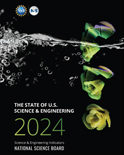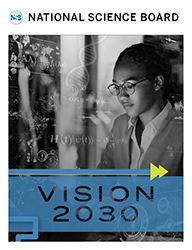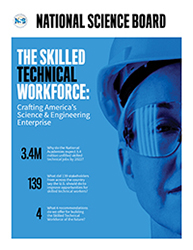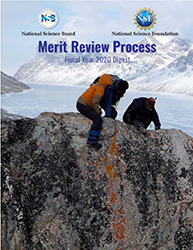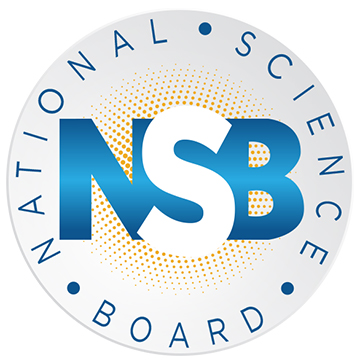
NSB Report Highlights Key Role of United States in Scientific Collaborations
Report also reveals wide variance in publication rates across U.S. demographic groups
October 28, 2021
China continues to publish more scientific papers than any other country in the world. In the United States, women and people in underrepresented groups are much less likely to publish papers before receiving a doctorate than their white, male counterparts. These and other data are in Publications Output: U.S. Trends and International Comparisons published today by the National Science Board (NSB).
Prepared by the National Center for Science and Engineering Statistics under NSB guidance, the new report is part of the 2022 edition of the congressionally mandated Science and Engineering Indicators report on the state of the U.S. science and engineering enterprise.
Publication output is a proxy for measuring science research. Although the rate of scientific papers coming out of the U.S. has grown steadily over time, the publication rates of other countries – including China – are growing rapidly, continuing a trend that began in the 2000s.
In 2020, China produced the most (23 percent) science and engineering publications with the U.S. second at 16 percent. As a group, EU countries produced 24 percent of the world’s research publications.
“Collaborating with researchers internationally is an essential part of how we advance science, attract talent from around the world, and avoid being technologically surprised,” said National Science Board member and Associate Vice President of the Southwest Research Institute Alan Stern.
Research articles that have authors from universities or research institutions in at least two countries indicate international collaboration. Authors from U.S. researcher collaboration, as shown by the institutional addresses of coauthors on articles, has grown from around one in seven articles in 2000 to more than one in three in 2020. China is the most frequent partner for the U.S. in these collaborative papers.
“These numbers show that China is both a chief collaborator and a competitor with the United States,” said Stern. “Policymakers should be cognizant of this information as we work to balance scientific collaboration with safeguarding research that could impact U.S. national security and economic competitiveness.”
The report also shows publication rates across several demographic groups in the U.S. One key finding: Asian, Black, and Hispanic graduates in most fields are significantly less likely to publish before gaining their doctoral degrees compared to their White counterparts. And compared to men, women in many fields – including the biological sciences, social sciences, and engineering – are significantly less likely to publish before graduation. The impact of this can be far-reaching for both individuals and society. Pre-Ph.D. publications appear to be a significant factor when obtaining a research job; for those with at least one pre-Pre-Ph.D. publication, 56 percent reported their first job had research as its primary activity compared to 37 percent of those without a publication.
“We know that while we’ve made some progress, women and many racial and ethnic groups remain underrepresented in science and engineering,” said Stern, referring to the NSB’s Vision 2030 report. “Science and the nation both benefit from greater diversity, and we need to address the systemic issues and barriers that lead to these differences in career outcomes.”
Other findings:
- Research papers from the U.S. continue to have high impact, on average, as measured by journal article citations. But beginning in 2017, articles from China received citations above the number expected, given the number of articles produced.
- In 2020, major research countries – the United States, China, the United Kingdom, and many European Union countries – were hubs of global coronavirus research collaboration.
The report reflects analysis of over 44 million articles published from 1996 to 2020, including conference papers, research articles published in conference proceedings, and peer-reviewed scientific and technical journals. It did not include working papers and preprints, which are not generally peer reviewed.
About Science and Engineering Indicators
Science and Engineering Indicators is a congressionally mandated report on the state of the U.S. science and engineering enterprise.
About the NSB
The NSB identifies issues critical to NSF’s future, establishes its policies, and serves as co-head of agency with the NSF Director. The Board also advises the President and Congress on policy matters related to science and engineering (S&E) and S&E education. Selected for their distinguished service and accomplishments in academia, government, and the private sector, the Board’s 24 presidentially appointed members are leaders in science and engineering, and in science, technology, engineering, and math (STEM) education.
About NCSES
The National Center for Science and Engineering Statistics (NCSES) is the nation's leading provider of statistical data on the U.S. science and engineering enterprise. As a principal federal statistical agency, NCSES serves as a clearinghouse for the collection, interpretation, analysis, and dissemination of objective science and engineering data.
Media Contacts
Alison Gillespie, National Science Board, (703) 292-2557, algilles@nsf.gov
Useful NSB Web Sites:
Home Page: http://www.nsf.gov/nsb
Media Contact: http://www.nsf.gov/staff/staff_bio.jsp?lan=nlymn&org=NSF
News: http://www.nsf.gov/nsb/news
Meetings: http://www.nsf.gov/nsb/meetings
Publications: http://www.nsf.gov/nsb/publications
Facebook: https://www.facebook.com/NationalScienceBoard
Twitter: Twitter: https://twitter.com/intent/user?screen_name=NSF_NSB
YouTube: https://www.youtube.com/channel/UCkrHRzuGSrPp2haQs0T_Pww
To view PDF documents, please download Adobe Acrobat Reader.
